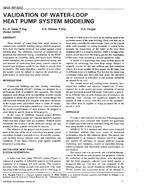Click here to purchase
Recently, an ASHRAE research project (RP-1328) was completed in which an algorithm for a hybrid model was developed (Kashef and Hadjisophocleous 2010). The hybrid model comprised two integrated models: a zone and a network model. The two-zone model was developed to simulate fire and smoke movement inside the room of fire origin and neighboring rooms. The network model capable of predicting both mass and energy flow is used to simulate smoke movement into the rest of the rooms that are far away from the fire-origin room. The two models were combined to produce a hybrid model that allows an accurate simulation of fire dynamics in both the near and far field. The output of the zone model provided a direct input into the network model that included the energy equation.
The different steps involved in the development of the hybrid model were included in Kashef and Hadjisophocleous (2011). The application of this model permits a reasonable numerical simulation (time and accuracy) of the fire process, which determines both mass flow and energy transfer over an entire high-rise building using a standard personal computer.
This paper presents the implementation of a hybrid model to simulate fires in different building geometries. The hybrid model combined two independent models: a zone model and a network model. The solution procedure consisted of two parts: simulation of two-zone model, which dealt with the room of fire-origin and neighboring rooms, and simulation of the network model, which included rooms far away from the fire. The two-zone and network models were first tested individually; then the performance of the integrated model was investigated in different types of applications.
Citation: ASHRAE Transactions, Volume 117, Part 1, Las Vegas, NV
Product Details
- Published:
- 2011
- Number of Pages:
- 9
- File Size:
- 1 file , 3.8 MB
- Product Code(s):
- D-LV-11-011


